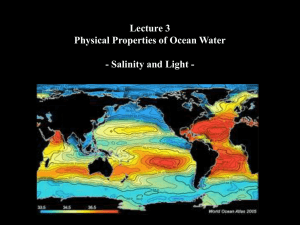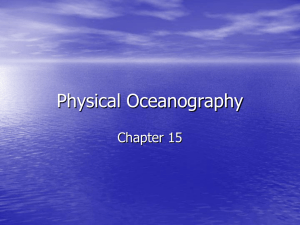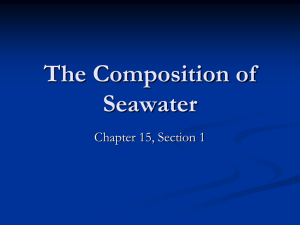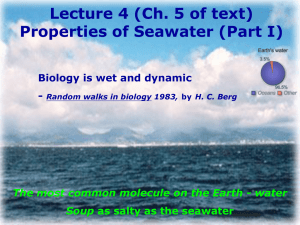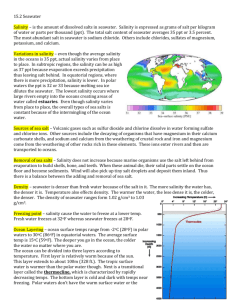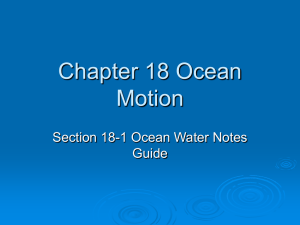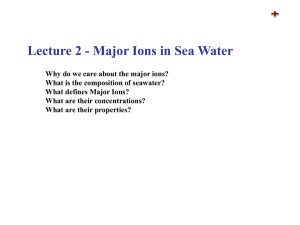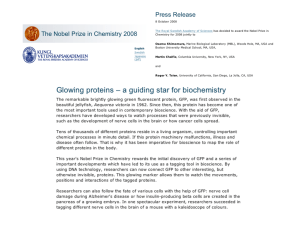Marine Chemistry
advertisement
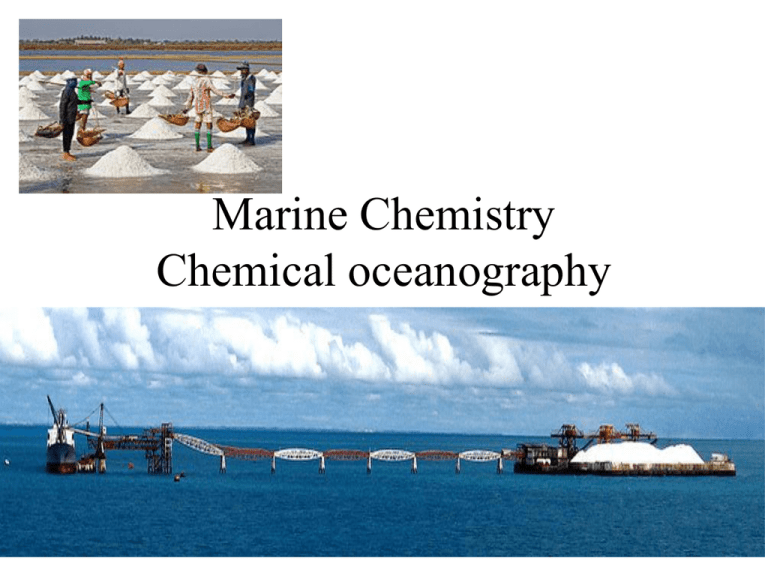
Marine Chemistry Chemical oceanography Objectives • Definitions. • Properties of sea water • Physical Properties of sea water • Temperature • Salinity • Density • Water circulations • Ocean • Temperature distribution in ocean • Salinity distribution in ocean • Sea water composition • Major Ions Conservative elements • Trace elements Dissolved gases • Micronutrients Organic matter Definition • Marine chemistry/ Chemical Oceanography is the study of Sea/ocean water chemistry • The ocean is unique (Why?) • It contains nearly every element in the periodic table. Behavior of Chemical elements within Ocean Marine Chemistry studies Describe cycles of elements Biogeochemical Cycle Behavior of isotopes and their role as tracers for past and present Cycle of Biologically active elements C, N, P, & trace Fe • Some Isotopes' applications • 1-The incidence of 18O (the heavy isotope of oxygen) can be used as an indicator of polar ice sheet extent. and • 2- Boron isotopes are key indicators of the pH and CO2 content of oceans in the geologic past. Properties Of Sea water • Water is the universal solvent because of its ability to dissolve at least a little of every substance. • Water is a particularly good solvent for substances held together by different bonds. Density Decreased • Activity #1 • What happened when we add salts to water? • Think about the following items? • 1- Density 3- Boiling point 2- Freezing point 4- Conductivity Density is increased. The freezing point is depressed The boiling point is elevated The conductivity is increased • The density is increased: • Any substance dissolved in a liquid has the effect of increasing the density of that liquid. • The greater the amount of solute, the greater the effect • As a result of the salt content in seawater, the density of seawater increases continuously with decreasing temperature. • There is no density maximum like for freshwater. • The colder the water temperature, the (heavier- lightermoderate) the water density. (Choose between brackets) • • The freezing point is depressed: • Salts lower the temperature at which water freezes • (This is why salt is spread on frozen roads). • That is because dissolved salts inhibit the tendency of water molecules to form direct bonds with other water molecules. • The freezing point of salty water is (higher than- lower than-equal to) that of pure water. (Choose between brackets • The boiling point is elevated: • The salts have the effect of making the water molecules cluster and become more “ordered” thus harder to pull apart and evaporate. • Activity #2 • Ice melts and mixes with seawater of salinity 35 g/kg. Will this have the effect of raising or lowering the freezing point of seawater? • How would this effect the formation of more sea ice when temperatures fell once more? • This will add fresh water, dilute seawater, make it less saline and raise the freezing point thus facilitate the formation of further sea ice. • The conductivity is increased: • The transport of electrons causing and electric current to flow is enhanced by the strong electrolyte nature of salts. • If an electromagnetic field is applied to a solution of strong electrolytes, the ions will migrate, producing an electric current (e.g. conductivity is increased). Temperature, Salinity, Density and Ocean Circulation Temperature Control Density That Governs Vertical Movement Of Ocean water Salinity Temperature and salinity are together two of the most important characters of sea water because …..(Complete). Temperature Distribution in the Ocean At the sea surface temperature is fixed due to exchange with atmospheric heat Incoming energy from the sun at the earth's surface is about 4 times at the equator> than at the poles Infrared radiation heat loss to space Is more constant with latitude There is a net input of heat to the earth's surface into the tropical regions, where we find the warmest waters Heat is transferred from low to high latitudes by winds in the atmosphere and by currents in the ocean. Salinity Distribution in the Ocean At the sea surface, salinity is controlled by Evaporation Precipitation The highest S‰ are found in sub-tropical regions centered at 20º to 3º North and South Evaporatio n > Rainfall Red Sea has The highest surface salinity Sea water Composition Major ions Dissolved gases Trace elements Diagram showing concentrations of various salt ions in seawater: Cl− 55%, Na+30.6%, SO2−4 7.7%, Mg2+ 3.7%, Ca2+ 1.2%,K+ 1.1% , Other 0.7%. Note that the diagram is only correct in units of wt/wt, not wt/vol or vol/vol. Major Ions • • • • • • • • • • Definition: Those elements whose concentration is greater than 1 ppm. Why 1ppm? Because Salinity is reported to ± 0.001 or 1 ppm. What are their effect? They contribute significantly to the salinity. How many? Eleven (11) major ions. What are names and ranking? Sodium> Magnesium> Calcium> Potassium> Strontium> chloride> Sulfate> Bicarbonate> Bromide> Borate> Flouride • Activity #2: • There are 11 major ions contribute significantly to salinity although of this Na+ and Cl- are the most dominant. (Explain) • The major ions are conservative. (why?) The major ions are conservative. This means that they have constant ratios, to one another and to salinity, in almost all ocean water. Sea salts have constant composition. They almost always consist of 55% sodium ion, 31% chloride, 8% sulfate, 4% magnesium ion, 1% calcium ion, and 1% potassium ion. The main exception is where freshwater is mixing with seawater. River water has a different composition than seawater, it contains more calcium ion. At a salinity of S = 35.000 seawater, The major ions concentration is >1mg/kg seawater. Na+ and Cl- account for >86% of the salt content. The order of dominance of the other cations is Mg2+ > Ca2+ > K+ > Sr2+. The anion Cl- is approximately equal to the sum of the cations. The other anions are barely significant in the charge balance of seawater. What are the synonym of other elements that their concentration are < than 1mg/kg seawater? Sea water composition Via river water Properties Sea water River water Amount/ Number Huge number of dissolved elements Low number of dissolved elements Sea water has 300 times more elements than river water Mixture Heterogeneous nearly Homogenous Different from sea water. Source Terrestrial Biogenic Cosmogenic Hydrogenic chemical weathering of rocks. recycled sea salts via rainfall Contribution Na+ and Cl- account for >86% of the salt content A minute fraction of river Cl- content (0.01%) from rock weathering. Most from recycled salts. Gases and Gas Exchange The ocean is a sink for anthropogenic CO2. The major transfer modes of CO2 to the ocean from the atmosphere is by gas exchange. Oxygen is a chemical tracer for photosynthesis. The gas exchange flux of O2 is an important parameter for calculating net biological production. Some gases can act as tracers for ocean circulation. • • • • • • • • • Trace Elements in Seawater: Definition: Those elements that do not contribute to the salinity. Concentrations: All elements are present in concentrations less than 1mg kg-1. Many are present at very low concentrations (>10-21 M). like 1 drop of ink in 100,000 liters of swimming pool. Restrictions This presents analytical challenges to measure and avoid contamination. Importance Many are nutrients and required to sustain life (e.g. P, N, Fe) Others are toxic (e.g. Cu, Hg) Some are tracers for re-dox conditions (Cr, I, Mn,). Some are tracers for pollution (Pb). Some form economic deposits such as manganese nodules (e.g. Cu, Co, Ni, Cd) • Macronutrients • Definition: • Macronutrients are those elements that are believed to be limiting to plant growth in the surface ocean. • Concentration • They have concentrations in the range of micromoles kg-1. • Components • Phosphate, nitrate and silicate are the important macronutrients. • Distribution • Po4-4 and NO3-3 have maximum concentrations shallower than silicate (Why?). • 1- Because maximum degradation of organic debris happens shallow in the thermocline. • 2- SiO2 increases with depth because of the dissolution of siliceous tests of diatoms, which dissolve deeper in the water column and on the sea floor. Dissolve Organic Matter (DOM) • Any material with a carbon atoms joined to each other, and often to H, O, N and P. • We study organic matter in seawater because: • 1. OM is the principle chemical form in which solar energy is made, stored, and used on Earth (source of fossil fuels). • 2. About 80% of the total particulate carbon flux through the thermocline is in the form of organic matter. • 3. About 20% of the total carbon buried in marine sediments is organic. • 4. Over geological time scales OM burial in marine sediments is a major source of atmospheric O2. Summary


